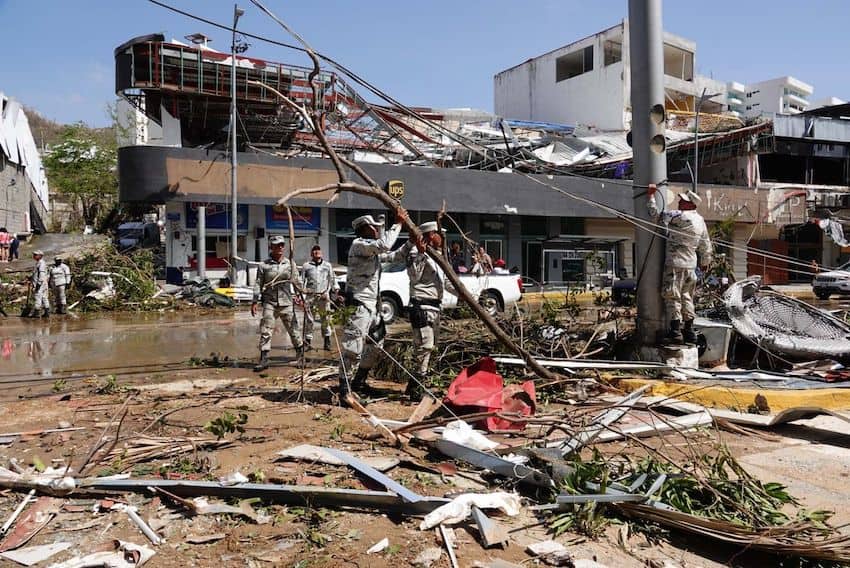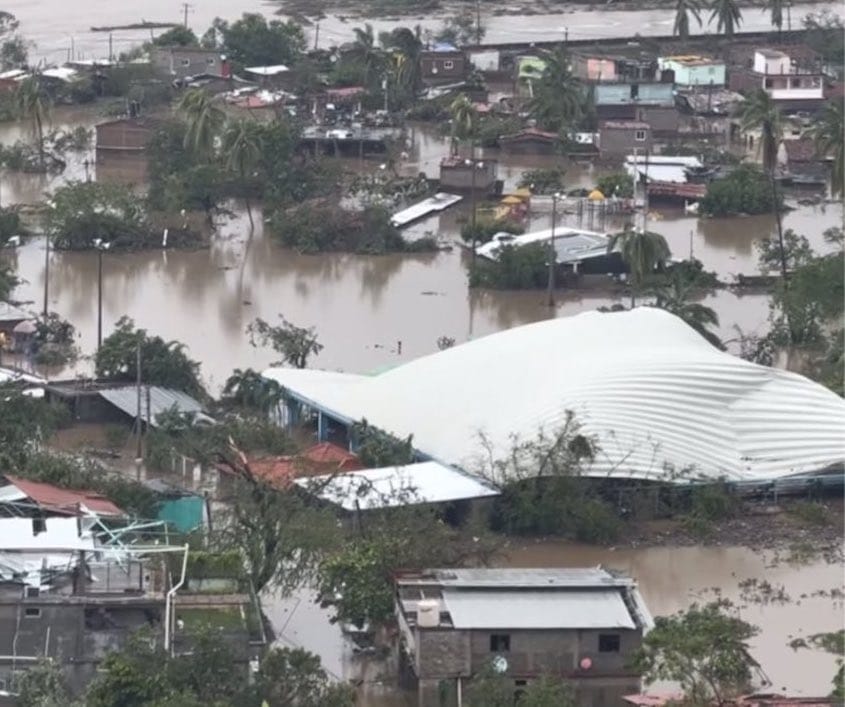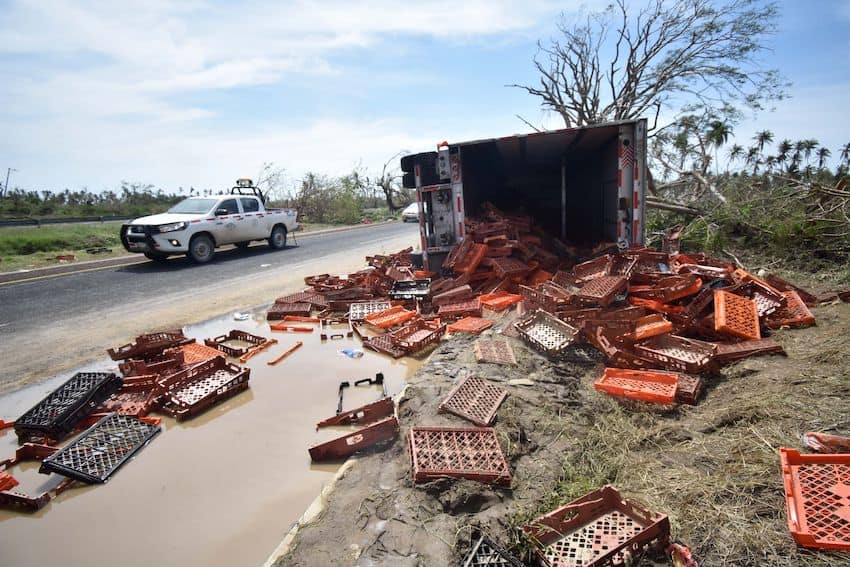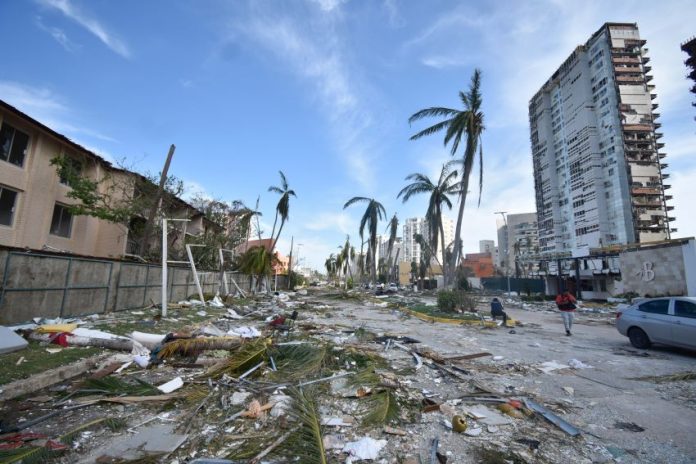The cost of damage caused by Hurricane Otis is likely around US $15 billion, according to a United States-based research company.
Otis slammed into the Pacific coast near Acapulco as a Category 5 hurricane early on Wednesday, causing extensive damage in the resort city and other parts of Guerrero.

On Thursday morning, the federal government reported a preliminary death toll of 27, with four additional people missing. The number of confirmed fatalities remained at 27 on Friday morning, but it appears inevitable that the death toll will rise.
Enki Research, a Georgia-based company that tracks storms and models the cost of their damage, said in a blog post that damage from Otis “is likely approaching $15 billion US dollars.”
The government has not yet estimated the cost of damage caused by Otis, but has announced a budget of 35 billion pesos (US $1.9 billion) to respond to the disaster. That amount could prove to be inadequate if the cost of the damage is indeed as high as Enki estimates.
President López Obrador has this week faced criticism for the 2021 abolition of the disaster relief fund Fonden (a public trust), which he described as “a kind of petty cash box for officials.”

In Acapulco, the hurricane caused major damage to hotels, stores, restaurants, shopping centers, apartment buildings and houses, toppled electricity transmission towers, destroyed cars and boats and provoked widespread flooding.
Otis also caused significant damage in other municipalities of Guerrero, such as Coyuca de Benítez, which borders Acapulco to the north.
Chuck Watson, the director of Enki Research, said that “nearly 3 million people experienced tropical storm force winds,” and many of that number faced winds of around 270 km/h when Otis made landfall shortly after midnight Wednesday.
Watson noted that the strength of the hurricane’s winds went from 60 miles per hour (96 km/h) to 170 mph (273 km/h) in the space of a day.

“That’s a tropical storm to Category Five in 24 hours and [Otis] made a direct hit on the port and resort area” of Acapulco, he wrote.
“To put that in context, remember wind energy is the square of wind speed, so while the winds were three times higher, that is nine times more energy in the peak wind! The impact on damage is even more dramatic — while 60 mph winds typically cause only limited damage to roofs and weaker structures, 170 mph wind causes catastrophic damage, completely destroying even reinforced buildings,” Watson said.
The Acapulco hotel association said Thursday that 80% of hotels in the city sustained damage. The iconic Princess Hotel was among them.
Photos and video footage showed the lobby filled with waterlogged mattresses, wooden furniture and debris. A white SUV also somehow made it into the lobby of the beachfront hotel.
Damage to hotels will only exacerbate economic losses as it will inevitably be some time before they are ready to once again welcome tourists. Acapulco’s high season for tourism is December to March.
López Obrador said Thursday that federal authorities will meet with hoteliers and business people on Monday with a view to “reestablishing tourism activities in Acapulco as soon as possible.”

The president, who made it to Acapulco by road on Wednesday night, also said that the Welfare Ministry will carry out a damage census to determine who qualifies for federal funds. Home and business owners will be taken into account, he said.
“We’re going to help with a reconstruction and home improvement program,” López Obrador said.
He said Friday that “we have to get Acapulco back on its feet as soon as possible because it’s a tourism symbol,” adding that “we’re not going to stop until normality returns and the port is recovered.”
With reports from El País and Bloomberg

This was not a “Storm” it was a manufactured event using HARP to destroy Acapulco. Paradise Station Ca, Lahina Maui and now Acapulco Mex. A few questions to ponder; why no warning issued to the public of the arrival of this disaster? Why is there no Government relief? Why are the roads blocked into Acapulco to local aid? If this was a storm why was there NO RAIN?
Just a few ideas to ponder
Really? What does conspiracy soup taste like?
I take that back…4 hurricanes in one season…I forgot about Maui.
How is that possible?
Tolling@lqmint.com…H.A.R.P. may be the answer.
I must admit…HOW DID NATURE MAKE A DIRECT HIT ON CABO, PUERTO VALLARTA AND ACAPULCO IN ONE SEASON? WHAT ARE THE ODDS ON THAT HAPPENING?
3 HURRICANES AND THREE DIRECT HITS.
JUST SAYIN….
Governments. Manipulating the weather. This is deliberate. Also. Global warming.
Puerto Vallarta was not directly hit at all. I live here and mostly trees were down. Comparing it to Acapulco is ignorant.
paul.minutillo@yahoo.com
I have a condo in PV and watched the track of the storm eye 30 miles south from the airport. The eye came in at Mayto where the strong right side of the storm was impacted.
The saving grace of PV is the Sierra Madre mountains wrap south west around the Bandaras Bay and outward for over thirty (30) miles. The mountain rises out of the bay at the point up to 2600 feet (over a 1/2 mile) high. The hurricane hit that WALL and destroyed it. The following flooding down the streets in PV were due to the remainder of the hurricane hitting the Lady of the Mountain at 5200 feet (1 mile high) and squeezing out the remainder of the rain that ran down the streets from the mountain. We are blessed in PV. For a hurricane to devastate PV it will have to go (as they say) “Crazy Ivan” after passing PV turn south, south, east and enter the bay. Highly unlikely. The worst part of hurricanes are the storm surges. Fortunately, the elevation is good but the water depth drops off 800 foot right near shore. I’m from Pass Christian, Mississippi. USA and Cat 5 Hurricanes are epic. We have 40+ foot storm surges as the water depth is only 100 feet deep at 100 miles off shore.
One other thing Mr. paul.minutillo@yahoo.com. Before you call someone ignorant you should make sure they don’t live in the same city. I will return December 5th and I invite you to come to Chappy’s in the Marina on Thursday the 7th at Noon and we can discuss your choice of language. I’ll be the 300 lb, 6’4″ guy at the bar wearing the Trump hat.
nutter
You better go get your booster.
Called “global warming”… Get used to it!
WRONG…the real scientist say the earth has not warming but cooling.
Net Zero Carbon will desolate the planet.
Bill Gates is releasing mosquitos with malaria and dengue fever while paying chem-trailing aluminum oxide $10 a gallon across the earth..
Now you may not believe that Fauci created HIV in the 1980’s in Africa or that he created COVID 19 or that they had the vaccines before the pandemic and people are not dying of shots with fresh aborted babies kidney T cell, or cobra venom or Bill Gates graphine oxide self replicating trans-human technology in the “vaccines either….but here we are with the WHO, the NIH and the NWO demanding to reduce population to 500,000.
There is no global warming or climate change.
If you still think these are coincidences then you are very gullible indeed.
Wait 6 months and your conspiracy will be a fact.
Times have changed, people do things not because they are right or moral but because they can and they will live stream it…the more upside down or backwards the more they do it.
These generations are stupid.
Gee, I never thought of it that way, ya NUT CASE LOL!
Wow….the number of nut cases yapping on this comment section is crazy. Now that everything the scientists have said would happen if we keep spewing fossil fuels into the atmosphere is happening, it is time for complete denial and conspiracy theories. The world is cooling?? Ahhh….now I know why there are ten times the forest fires there were 20 years ago, and there are 4 high temperature records broken for every 1 cold temperature record broken. The sky is green and 1 +1 = 3.
There was an old writer and poet in Mississippi names Samuel L. Clements / Mark Twain whom said:
IT IS EASIER TO FOOL SOMEONE THAT TO CONVINCE THEM THEY HAVE BEEN FOOLED.
If you took those shots, it was the biggest irreversible mistake of your short life.
Missouri
Missouri what?
Wow, people lost their lives and all you care about is using the opportunity as a platform for your conspiracy theories. People are grieving. Shame on you.
and you contribute nothing but a high castle attitude.
i see the Q perspectives are in full force today
I’m guessing it’s the full moon.
Right on!
The fund is $1.5 billion which appears to be about 90% too low, but the estimate is $15 billion in damage. First, some percentage of that will be covered by insurance. If it were the US, a very large percentage. Much less in Mexico. (Plus if you think insurance agencies try to get out of paying claims there, try to imagine what it’s like here!)
What damage the government needs to worry about for recovery is restoring all the infrastructure, not rebuilding damaged private commercial structures. Which isn’t to say that those things aren’t necessary for Acapulco to survive, rather that it’s not the role of the government.
Of course finding food, clothing, and shelter for the victims is also important, but that’s not really part of a “damage” estimate. And I doubt that will use much of the $1.5 billion.
Give or take officials overpaying for those supplies and services, per Mexican norms.
https://mexiconewsdaily.com/news/disaster-relief-fund-was-petty-cash-box-for-corrupt-officials-amlo/
Thanks to those who contributed real information on this chat. And to the conspiracy theorists, please seek therapeutic help. Your mental and physical health is at risk. I have lost friends to this – one good friend thought the vaccine was a conspiracy, didn’t get it, took ivermectin instead, and then died of covid. Completely preventable, and now his poor wife with Alzheimer’s is all alone. He was a good, rational, spiritual man, and a strong outdoorsman (hunting guide in Alaska) until right around when Trump was elected. He got anxious, and started going online. Eventually he didn’t trust anything or anybody, including his own personal physician.
A couple years ago I canceled my subscriptions to newspapers and periodicals in the US because the media is full of nothing but this type of bullshit. One of the biggest draws of Mexico for me is the lack of this type of vile, ignorant political discussion. Please don’t pollute Mexico with American politics. What the Hell are Trumpers doing in Mexico anyway. According to their Supreme leader, Mexico is full of nothing but murderers, rapists, & drug dealers. Trump doesn’t want your support if you support Mexico. Remember he is the one who separated Mexican children from their families years ago and hundreds still haven’t been reunited with their families. I would he careful wearing that Trump hat in parts of Mexico. Most locals I speak to, all call Trump a pendejo.
You did watch msm because it was Obama that built the cages that separated the children. Under OBiden over 58,000 children have been lost to child sex slavery in the USA open border policy in the past three years. (source:CBP Congressional testimony)
It’s globalism you are in denial of and Europe LOVES Trump. I brought a suit case of Trump hats and people “begged to buy them off of my head”. Europeans know the facts of Globalist One World Order and are also suffering the muslim invasion. You suffer from the Nevil Chamberlain disease of isolationism and illusion of peace. It didn’t work in WWI or WWII and it is not going to work as WWIII is approaching from the east. Only time will tell when the terrorist start attacks this year or next year in the USA due to 8 million unvetted illegal migrants. Ironic how the black Mayor of NYC is in Mexico talking to AMLO about illegal migrants destroying his city. Mexico is not of immediate importance but make no mistake…if the USA goes down…nothing will stop the communist from Central and South America because AMLO is silly putty in their hands. Only 10% of blacks voted for Trump in 2020 but new msm polls have 44%+ voting for Trump in 2024 and the numbers are rising exponentially with Hispanics from 27%+ in 2020 and the Dumbocrats are panicking. Trump was right about everything. How is Trump a racist when he dated a black woman living with him in Mar-a-lago and Trump tower for 2 years before he met Malania?
The USA has a MAGA Speaker of the House and Republicans are united against RINO’s and Democrats, marxist, anarchist, BLM terrorist, antifascist terrorist, NWO Globalist, LGBTQxyz terrorist, communist, and muslims.
MAGA are the majority in the USA and the Republic will be saved.
If you martyred Trump tomorrow it will not stop the MAGA movement.
Dumbocrats fail upward at everything from A to Z on foreign and domestic policy.
*I suggest you get your vaccination and boosters up to date immediately.
anyone with half a brain concurs with the pendejo moniker, even the ones that will then blindly support that thing – it’s infuriating and exhausting
I despair when I read all these comments by people who think that “the government” or some other malevolent force is spending fortunes of money and violating all known scientific possibility (creating hurricanes?? Really??) in order to harm people and destroy property for no apparent reason whatsoever. Mental illness is apparently a lot more prevalent in the population than I suspected.
Meanwhile, I can’t seem to find in any news article a legitimate, well-run organization where I can send money to help with at least the immediate humanitarian crisis of this disaster.
Good grief!